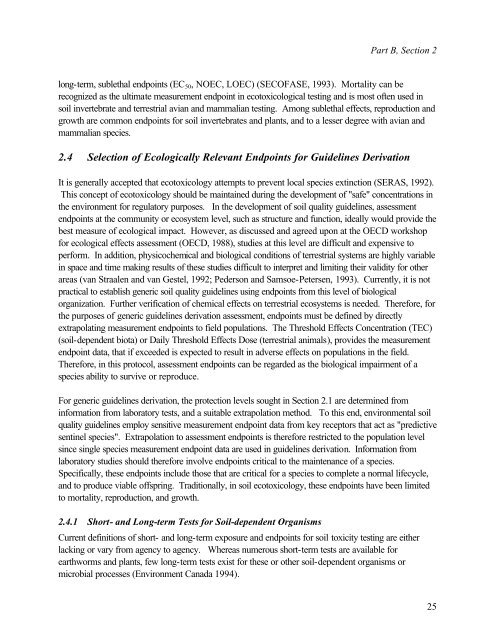Protocol for the Derivation of Environmental and Human ... - CCME
Protocol for the Derivation of Environmental and Human ... - CCME
Protocol for the Derivation of Environmental and Human ... - CCME
You also want an ePaper? Increase the reach of your titles
YUMPU automatically turns print PDFs into web optimized ePapers that Google loves.
Part B, Section 2<br />
long-term, sublethal endpoints (EC 50 , NOEC, LOEC) (SECOFASE, 1993). Mortality can be<br />
recognized as <strong>the</strong> ultimate measurement endpoint in ecotoxicological testing <strong>and</strong> is most <strong>of</strong>ten used in<br />
soil invertebrate <strong>and</strong> terrestrial avian <strong>and</strong> mammalian testing. Among sublethal effects, reproduction <strong>and</strong><br />
growth are common endpoints <strong>for</strong> soil invertebrates <strong>and</strong> plants, <strong>and</strong> to a lesser degree with avian <strong>and</strong><br />
mammalian species.<br />
2.4 Selection <strong>of</strong> Ecologically Relevant Endpoints <strong>for</strong> Guidelines <strong>Derivation</strong><br />
It is generally accepted that ecotoxicology attempts to prevent local species extinction (SERAS, 1992).<br />
This concept <strong>of</strong> ecotoxicology should be maintained during <strong>the</strong> development <strong>of</strong> "safe" concentrations in<br />
<strong>the</strong> environment <strong>for</strong> regulatory purposes. In <strong>the</strong> development <strong>of</strong> soil quality guidelines, assessment<br />
endpoints at <strong>the</strong> community or ecosystem level, such as structure <strong>and</strong> function, ideally would provide <strong>the</strong><br />
best measure <strong>of</strong> ecological impact. However, as discussed <strong>and</strong> agreed upon at <strong>the</strong> OECD workshop<br />
<strong>for</strong> ecological effects assessment (OECD, 1988), studies at this level are difficult <strong>and</strong> expensive to<br />
per<strong>for</strong>m. In addition, physicochemical <strong>and</strong> biological conditions <strong>of</strong> terrestrial systems are highly variable<br />
in space <strong>and</strong> time making results <strong>of</strong> <strong>the</strong>se studies difficult to interpret <strong>and</strong> limiting <strong>the</strong>ir validity <strong>for</strong> o<strong>the</strong>r<br />
areas (van Straalen <strong>and</strong> van Gestel, 1992; Pederson <strong>and</strong> Samsoe-Petersen, 1993). Currently, it is not<br />
practical to establish generic soil quality guidelines using endpoints from this level <strong>of</strong> biological<br />
organization. Fur<strong>the</strong>r verification <strong>of</strong> chemical effects on terrestrial ecosystems is needed. There<strong>for</strong>e, <strong>for</strong><br />
<strong>the</strong> purposes <strong>of</strong> generic guidelines derivation assessment, endpoints must be defined by directly<br />
extrapolating measurement endpoints to field populations. The Threshold Effects Concentration (TEC)<br />
(soil-dependent biota) or Daily Threshold Effects Dose (terrestrial animals), provides <strong>the</strong> measurement<br />
endpoint data, that if exceeded is expected to result in adverse effects on populations in <strong>the</strong> field.<br />
There<strong>for</strong>e, in this protocol, assessment endpoints can be regarded as <strong>the</strong> biological impairment <strong>of</strong> a<br />
species ability to survive or reproduce.<br />
For generic guidelines derivation, <strong>the</strong> protection levels sought in Section 2.1 are determined from<br />
in<strong>for</strong>mation from laboratory tests, <strong>and</strong> a suitable extrapolation method. To this end, environmental soil<br />
quality guidelines employ sensitive measurement endpoint data from key receptors that act as "predictive<br />
sentinel species". Extrapolation to assessment endpoints is <strong>the</strong>re<strong>for</strong>e restricted to <strong>the</strong> population level<br />
since single species measurement endpoint data are used in guidelines derivation. In<strong>for</strong>mation from<br />
laboratory studies should <strong>the</strong>re<strong>for</strong>e involve endpoints critical to <strong>the</strong> maintenance <strong>of</strong> a species.<br />
Specifically, <strong>the</strong>se endpoints include those that are critical <strong>for</strong> a species to complete a normal lifecycle,<br />
<strong>and</strong> to produce viable <strong>of</strong>fspring. Traditionally, in soil ecotoxicology, <strong>the</strong>se endpoints have been limited<br />
to mortality, reproduction, <strong>and</strong> growth.<br />
2.4.1 Short- <strong>and</strong> Long-term Tests <strong>for</strong> Soil-dependent Organisms<br />
Current definitions <strong>of</strong> short- <strong>and</strong> long-term exposure <strong>and</strong> endpoints <strong>for</strong> soil toxicity testing are ei<strong>the</strong>r<br />
lacking or vary from agency to agency. Whereas numerous short-term tests are available <strong>for</strong><br />
earthworms <strong>and</strong> plants, few long-term tests exist <strong>for</strong> <strong>the</strong>se or o<strong>the</strong>r soil-dependent organisms or<br />
microbial processes (Environment Canada 1994).<br />
25
















